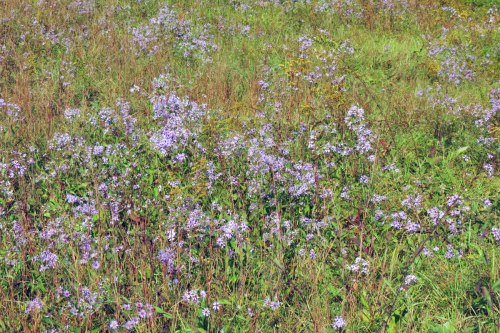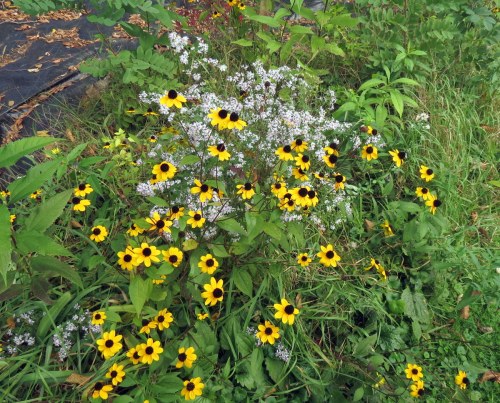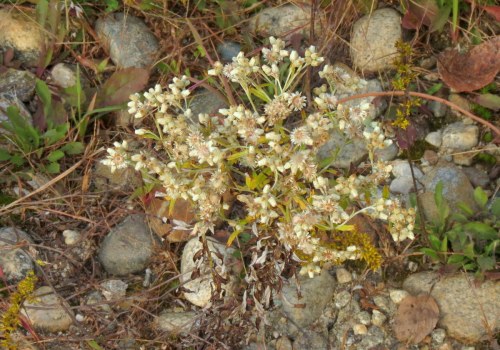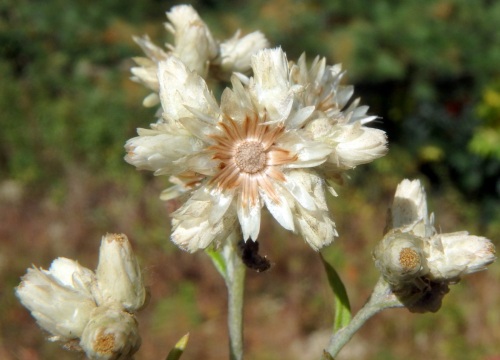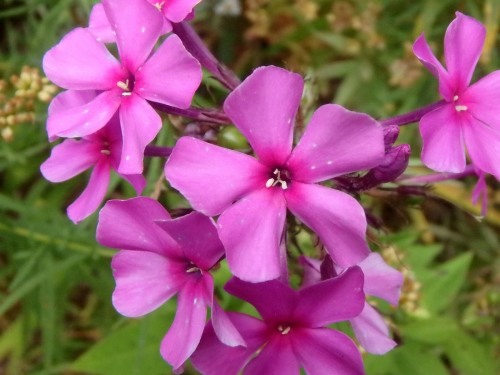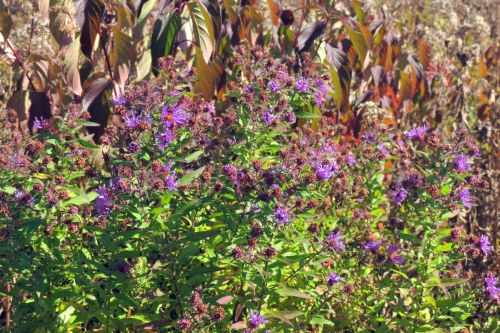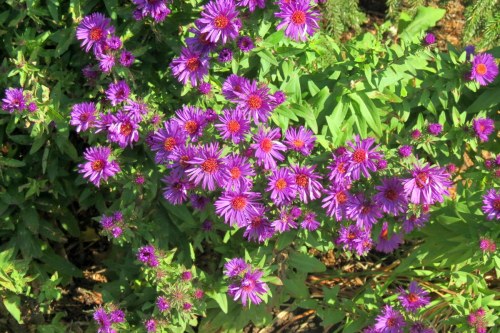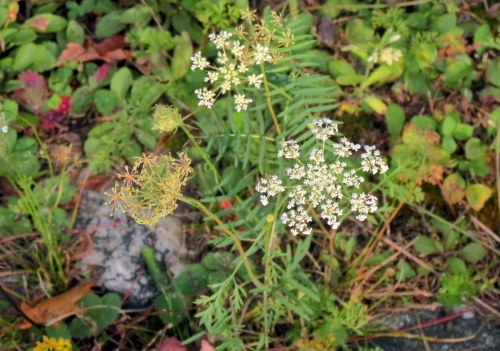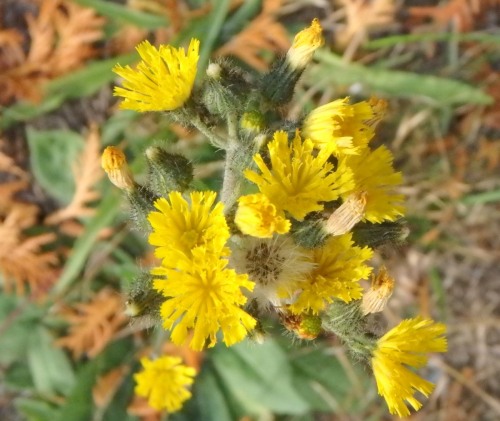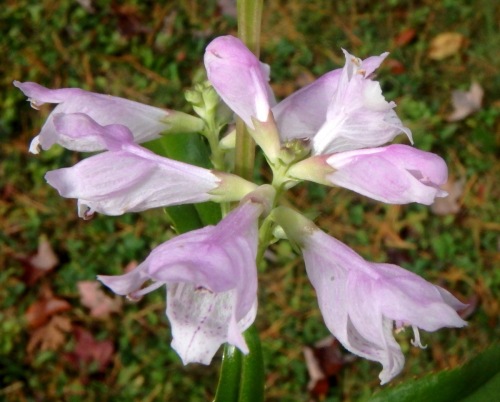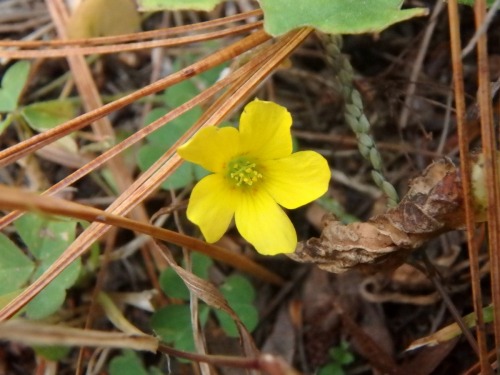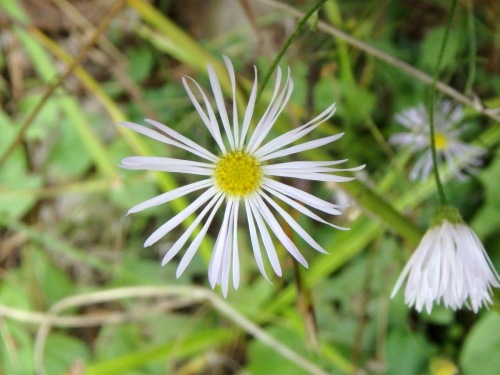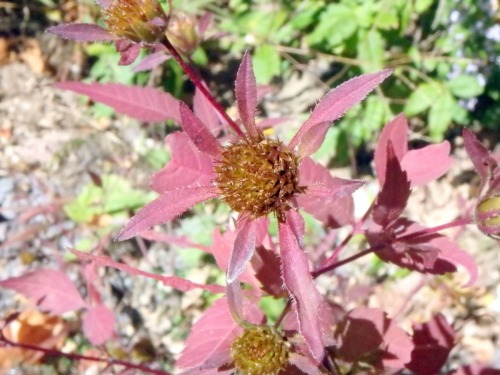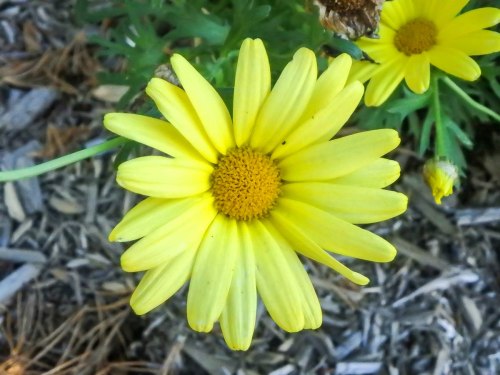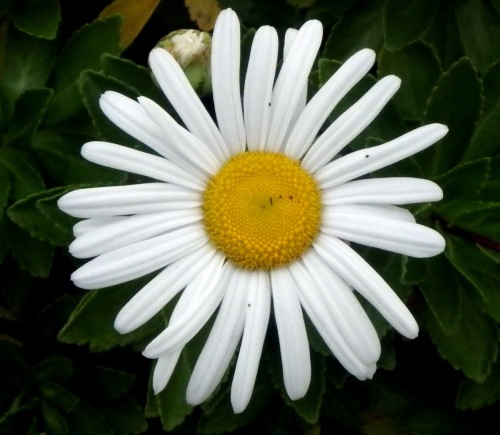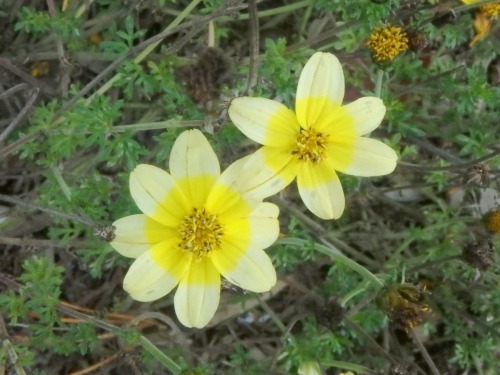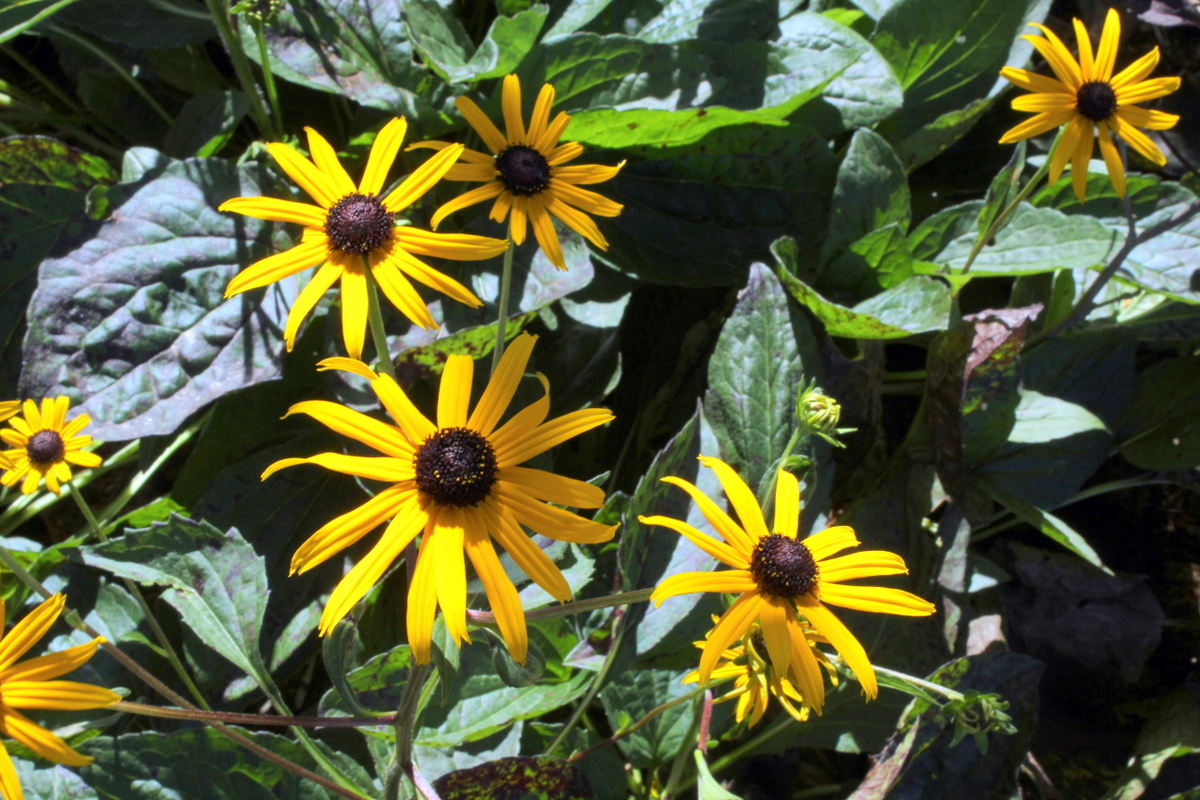
On a recent visit to my daughter’s garden I saw these glass baubles in one of the beds. They had spilled out of a flower vase and they just happened to be my favorite color, so I took a photo of them. What I didn’t see at the time was the lily reflection, which can be seen in the upper left corner of the photo.

This isn’t the lily that was reflected in the glass bauble but what a lily; it was beautiful, as were several others she grew. Clearly she has gardening in her genes but thankfully, she doesn’t want to make a living at it as I once did. It is a hugely rewarding but also an exhausting career that can make your body old before its time, especially when you work with stone.

She grows a lot of plants that I haven’t seen, like this “snap dragon vine,” which was a beautiful thing. Apparently it is native to Mexico and the southwest. Since my son lives in New Mexico at the moment, I asked him about it. I couldn’t imagine such a lush thing growing in such heat but he says northern parts of the state are forested and mountainous, much like here.

I noticed one of those metallic blow flies on a false sunflower. I’m seeing a lot of them this summer.

She has a lot of beautiful zinnias in her garden. I was hoping to see butterflies visiting them but we have a serious lack of butterflies here this year, so all I saw were bees and dragonflies. She puts pans of water out so the birds and insects can drink but still, no butterflies on this day. I’ve seen one or two great spangled fritillaries, a few white admirals, and a single viceroy, but no monarchs yet. I’ve been wondering if the drenching downpours we’re having have shredded their wings.

Another flower she grows that I hadn’t seen is the fiddleback. I looked them up online and saw some that looked just like a fern fiddlehead uncurling in spring. They’re in the borage family and are quite pretty.

She grows lots of vegetables and herbs as well as flowers. Since I’ve been talking about legumes this summer, here is a pea blossom, with the expected standard and keel. She also had pole beans but for some reason I couldn’t get a shot of a flower. Everything she grows is in raised beds full of wonderful things like cow and horse manure and compost. The plants obviously love it; these pea plants had climbed up over my head.

She also grows my favorite oxalis. I’m surprised that she doesn’t grow more housplants, because she grew up in an indoor jungle. I once grew so many housplants that I used to tell people who were coming to visit that they had better bring a machete, and I was only half joking. There were trees, ferns, vines, and everything in between. Come to think of it maybe that’s why my daughter doesn’t grow very many houseplants.

She grows some white petunias that have this curious deep purple marking in them. She grows all her plants from seed and I think she said these were saved seeds from last year. In any case it was a petunia I had never seen, and I’ve had my nose in an awful lot of petunias. I had my nose in these as well, because they’re fragrant petunias.

This is one of many sunflowers that my daughter grows. I realized after I had left her house that I hadn’t gotten wider views of the gardens, but I think that showing flowers rather than the gardens they grow in comes naturally to a gardener. I spent a large part of my life on my hands and knees weeding and deadheading gardens and when you’re in that position your eyes are right at flower level, so you look into them rather than at them and focus on the health of each plant rather than the garden as a whole. Depending on the cause one sick plant can make an entire garden sick, so I always made sure I watched each plant closely. I was right there on my hands and knees anyway so it wasn’t as hard as it might seem. But I’ll have to go back again and see if I can’t get some wider shots. I’d like to see those fiddlebacks unfurling as well.

I haven’t spent all my time in my daughter’s garden. I’ve also been out exploring places like this. The growing season is far from over and we have an explosion of growth going on right now.

The wild lettuces are blooming. Giant ten foot tall plants will have a few pencil eraser size flowers, colored green or blue, at the very top. This was a blue one but it was more white than blue. Maybe ice blue. The green ones are far more common than the blue, so I have to search for the blue ones.

Tall asters are one of the first of the asters to bloom and here they are, right on schedule. Next will come big leaf asters, white whorled wood asters, New England asters, and many more. I’ve seen tall asters that towered over my head but these were right at eye level.

Dragonflies are still flying everywhere I go so I will often stop and see if I can get a shot of one. They are always a challenge but this blue dasher was willing to pose.

Slaty skimmers are also still very active. I do all I can to get those wing patterns in a shot because I think the ones on this dragonfly are very beautiful. Somehow I got 3 out of 4.

I’m seeing more bees, flies, and dragonflies this year than I ever have. And mosquitoes; bug spray is a must if you’re going to spend time in the woods.

While I was there I thought I’d try to show you a single Queen Anne’s lace flower. I think there are actually two or three here but it was the best I could do with so many bees flying around.

I saw a bird in a bush, and I believe it was a catbird. These birds have been flying from bush to bush, following me as I walk along in this area. You would think that they’d be easy to see but it was all I could do to find this one with the camera at a few yards away. When I finally did find it I had one hand held shot, and this is it. Birds, dragonflies, and many other insects will stay still and watch you fumble with your camera settings, but as soon as you point that lens at them they’re gone in a streak, just as this bird was. It might be colorblindness that makes them so hard for me to see, I don’t know.

I’m seeing a lot of Canada goose families with goslings almost as big as their parents now. I don’t say much about it but many goslings are lost to snapping turtles, hawks, foxes, bobcats, and other predators each year. I’ve seen large families reduced to one gosling when I was able to watch them each day. This year though, they seem to be doing well. Humans also prey on adult geese so they are wary. They’re a bird that will sometimes put up with you but more often than not they’ll turn and show you their tail. It seems to depend on how quietly you move and how close you are to them. This bird swam in liquid sunshine and I thought it might be too lost in bliss to notice me but no, it turned away.

Our wild clematis called Virgin’s bower has just started flowering. This vine, with its masses of small white flowers, drapes itself over the tops of shrubs to get maximum sunlight and it’s very common along railtrails and roadways. Another name for it is traveler’s joy, and that it is. Sweet autumn clematis, which is a cultivated variety of small, white flowered clematis, comes closest in both habit and flower size.

Shy little Deptford pinks have started blooming. These plants are not as showy or as prolific as their cousins the maiden pinks, and the flowers are smaller. I always have to look in places I know they grow in to find them. They’re quite pretty though, and always worth looking for.

I’ll go from the tiny Deptford pink to this beautiful daylily, which was the biggest daylily blossom I’ve ever seen. It grows in a local park and is so big I couldn’t cover it with my hand, even though I had stretched out all my fingers. Every gardener has an image in their mind of what a daylily looks like but I had to stand for a while and give my mind time to discard the old image and build a new one. This will surely be the flower size that all future daylily breeder introductions will be measured against. It’s amazing.

Jewelweed has just come into bloom and this is the first blossom I saw. They appear at the end of long thin stems (Pedicels) and they move with the slightest breeze, so they can be a challenge to photograph. The common name of the plant comes from the way raindrops sparkle on its leaves, not from its flowers. The leaves have a wax coating that resists water absorption, and that’s why raindrops sit and sparkle like drops of mecury on jewelweed leaves.

Imagine a bee having to crawl down through a pincusion of pistils to get to a flower’s pollen and you have the button bush flower head. Crawling down through all those sticky pistils means it will brush against some of them and leave any pollen it has on its body with them, and that’s exactly the strategy that has evolved in the buttonbush. I see lots of seed heads on buttonbush plants so it must work well. Later on ducks, geese, and songbirds will come along to eat up all the seeds, and they’ll spread them far and wide to make new button bushes. If you have wet spots in your yard or are lucky enough to have a stream running through it, plant a buttonbush or two. If nothing else it will surely be a conversation starter.
The old school of thought would have you believe that you’d be a fool to take on nature without arming yourself with every conceivable measure of safety and comfort under the sun. But that isn’t what being in nature is all about. Rather, it’s about feeling free, unbounded, shedding the distractions and barriers of our civilization—not bringing them with us. ~Ryel Kestenbaum
Thanks for coming by.























